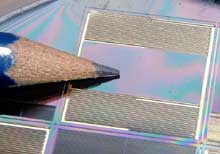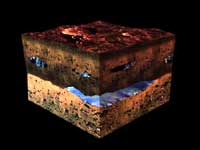
Researchers at Imperial College London have just begun a 5-year project to design and build tiny earthquake measuring devices to go to Mars on the 2007 NetLander mission.
Unlike the instruments on next year`s European Mars Express/Beagle II mission, the Marsquake sensors will be the first to look deep inside the planet.
The internal structure of Mars is a key to understanding some fundamental questions about the planet including whether life ever existed there.
The sensors are c

“The presence of such a large amount of water ice under Mars`s surface is very surprising. Especially so close to the surface!” says Gerhard Schwehm, Head of the Planetary Missions Division at ESA. The team working on ESA`s Mars Express, the next mission to the Red Planet, is thrilled by NASA`s Mars Odyssey detection of hydrogen-rich layers under the Martian surface. This hydrogen indicates the presence of water ice in the top surface of the Martian soil in a large region surrounding the planet`s so

Giving magnesium sulphate injections to pregnant women with pre-eclampsia halves the risk of eclampsia developing and can save their lives. This is the conclusion of a major international clinical trial funded by the Medical Research Council (MRC) and published in this week’s The Lancet.
The three-year £2.5 million study, the ‘Magpie’* Trial, was conducted in 33 countries spanning the UK and much of the developing world where eclampsia is the most common cause of death for pregnant women. Th

Pulses of laser light can make molecules react in ways that are impossible using classical test-tube chemistry. Molecules vibrate, and each molecule has its own “tone,” its own “melody.” It’s a question of finding the right key, and that is something that a “smart” laser beam can do. It can find its way to the right tone. In a new issue of the prestigious journal Nature it is shown how such a laser can be used to control photosynthesis molecules that gather light. This is the first time this fea

New product approved to prevent bleeding deaths
A razor nick during a much-too-close-shave ten years ago may result in hundreds of thousands of lives saved in the future. Scientist Frank Hursey was working with absorptive materials back in the late 80’s when he cut himself shaving. He picked up a volcanic mineral he’d been studying and decided to try it on his bleeding wound. The product worked so well as a coagulant that Hursey set to work doing further testing.
After three

A new and economical technology for the separation and capture of carbon dioxide from industrial processes could lead to a significant reduction in greenhouse-gas emissions to the atmosphere. Scientists at the Department of Energy’s Los Alamos National Laboratory are developing a new high-temperature polymer membrane to separate and capture carbon dioxide, preventing its escape into the atmosphere. This work is part of the DOE Carbon Sequestration Program’s mission to reduce the amount of c

– new calculation confirms standard model of particle physics. Contribution of hadronic vacuum polarization determined with unprecedented accuracy. The magnetic moment of the muon is an important precision parameter for…
Technique may prevent formation of unwanted waves that siphon off needed energy. Heating plasma to the ultra-high temperatures needed for fusion reactions requires more than turning the dial on a…

An international team of astronomers, led by researchers from the Astronomical Observatory of the University of Warsaw, have identified a new class of cosmic X-ray sources. The findings have been…

Antibody that Neutralizes Inhibitory Factors Involved in Nerve Regeneration Leads to Enhanced Motor Function after Acute Spinal Cord Injury. Researchers at 13 clinics in Germany, Switzerland, the Czech Republic and…

How the body’s natural killer cells could fight leukemia. Every year, some 13,000 people in Germany are diagnosed with leukemia. Despite intensive chemotherapy, around one in two of them die….

… eco-friendly reactor converts air and water into ammonia. Producing enough ammonia to feed the world comes with a large carbon footprint;. process described in new UB-led study could help…

How simulations help manufacturing of modern displays. Modern materials must be recyclable and sustainable. Consumer electronics is no exception, with organic light-emitting diodes (OLEDs) taking over modern televisions and portable…

“Neurons that fire together, wire together” describes the neural plasticity seen in human brains, but neurons grown in a dish don’t seem to follow these rules. Neurons that are cultured…

The quest for sustainable energy solutions has been a major focus of scientific research for decades. Solar energy, a clean and renewable source, has emerged as a promising alternative to…

With a processing speed a billion times faster than nature, chip-based laser neuron could help advance AI tasks such as pattern recognition and sequence prediction. Researchers have developed a laser-based…

New technology could remotely identify various types of plastics, offering a valuable tool for future monitoring and analysis of oceanic plastic pollution. Researchers have developed a new hyperspectral Raman imaging…

Artificial Intelligence (AI) has established a strong presence across industries, large and small. The “VoBaKI” research project has empowered small and medium-sized enterprises (SMEs) with an innovative tool to independently…